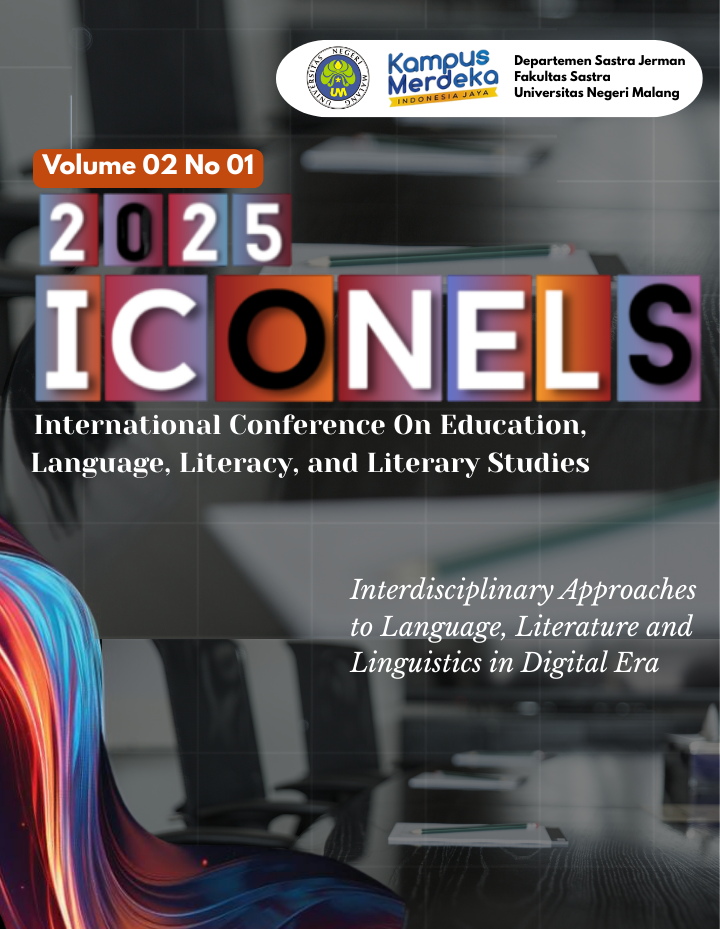Analysis of Shifting Meaning of Expressions in German Cultural Contexts
DOI:
https://doi.org/10.63011/iconels.v2i1.77Keywords:
idioms, shifting meanings, cross cultural, interpretationAbstract
The purpose of this study is to identify the context that affects meaning, especially the meaning of idioms in German, which is expected to help improve understanding in cross-cultural communication skills between languages. Communication is an important part that is done by humans as social beings in order to fulfill their needs. It involves not only the transfer of words but also the exchange of cultural values, emotions, and intentions. Throughout the communication process, there are several errors in conveying information due to inaccurate interpretation of meaning. Misunderstandings often arise when idiomatic expressions are interpreted literally, rather than contextually, especially by language learners. Besides, this study answers three main research questions: how to understand the context of meaning in German idiom expressions; what is the function and role of idiom meaning (Redewendungen); and are there any relationships between idioms and cultural contexts. By using qualitative research methods such as media analysis, on the YouTube platform, this study aims to gather insights into idioms used in daily German communication. Analyzing idioms through authentic media content provides a more realistic and culturally grounded understanding of how they are actually used. It also helps highlight the connection between language use and cultural perception in real-life situations.
References
Ajjawi, R., & Higgs, J. (2019). Hermeneutic phenomenology: The question of meaning in research. Qualitative Research Journal, 19(3), 261–270.
A.Joseph DeVito, Komunikasi Antarmanusia: Kuliah Dasar ed.5. Alih Bahasa Agus Maulana. Jakarta: Professional Books, 2011.
Indrawati, R. (2021).
YouTube sebagai Media Pembelajaran Bahasa Asing: Studi pada Mahasiswa Pendidikan Bahasa Jerman. Jurnal Perspektif Pendidikan dan Kebudayaan, 13(2), 134–145.
Bogdan, R. C., & Biklen, S. K. (1992). Qualitative Research for Education: An Introduction to Theory and Methods. Boston: Allyn and Bacon.
Creswell, J. W., & Creswell, J. D. (2017). Research design: Qualitative, quantitative, and mixed methods approaches. Sage publications.
Handayani, R. (2020).
Pemaknaan Idiom Bahasa Inggris dalam Media Sosial dan YouTube: Pendekatan Semantik Kontekstual. Jurnal Bahasa dan Komunikasi, 9(1), 47–56.
Laverty, S. M. (2022). Hermeneutic phenomenology and phenomenology: A comparison of historical and methodological considerations. International Journal of Qualitative Methods, 21, 1–10.
Littlejohn, S. W., & Foss, K. A. (2010). Theories of human communication. Waveland press. Fernando, C. (1996). Idioms and idiomaticity. Oxford: Oxford University Press.
Nasution, M. (2021). Analisis Hermeneutika Terhadap Makna dalam Wacana Media Sosial. Jurnal Al-Munzir, 14(2), 112–125.
Rahmawati, E., & Nugroho, A. (2020). Strategi Pemaknaan Idiom dalam Terjemahan Novel Bahasa Jerman ke Bahasa Indonesia. Jurnal Linguistik Terapan, 10(1), 33–42.
Richards, J. C., & Schmidt, R. (2010). Longman Dictionary of Language Teaching and Applied Linguistics. Pearson Education.
Rorong, M. J. (2019). Penempatan Teori Dalam Ilmu Komunikasi:(Kajian Kepustakaan Dalam Perspektif Deductive-Interpretive). Commed Jurnal Komunikasi dan Media, 4(1), 90-107.
Suryana, D. (2022). Pendekatan Hermeneutika dalam Penelitian Kualitatif Bahasa dan Sastra. Jurnal Pendidikan Bahasa dan Sastra Indonesia Metalingua, 7(1), 1–11.
Patton, M. Q. (2002). Qualitative research and evaluation methods (Vol. 3). Sage.
Wright, J. (2002). Idioms Organiser: Organised by Metaphor, Topic and Key Word. Thomson/Heinle.
Downloads
Published
Issue
Section
License
Copyright (c) 2025 Aigna Zhalfa Azzafranty Sugiarto, Anisa Mirsa Bintari Putri, Jessica Estrella Maya Doko

This work is licensed under a Creative Commons Attribution-NonCommercial-ShareAlike 4.0 International License.



